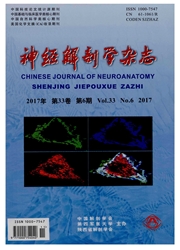

 中文摘要:
中文摘要:
目的:观察脊髓背角超极化激活环核苷酸门控阳离子通道(HCN通道)在坐骨神经缩窄性损伤(CCI)所致的慢性神经病理性疼痛中的作用。方法:8周龄成年雄性SD大鼠48只随机分为6组:(1)sham组(假手术组)、(2)CCI组(鞘内注射生理盐水)、(3)~(6)ZD7288+CCI(鞘内分别注射1,10,30,50μg ZD7288),每组8只。CCI及CCI+ZD7288组大鼠在鞘内置管5 d后行CCI术,术后鞘内给药,每日两次,连续14 d;sham组大鼠不进行鞘内置管,仅游离坐骨神经,不结扎。分别于CCI术前1 d,术后1、3、5、7、10、14 d鞘内给药2 h后测定热缩足潜伏期(TWL);术后第7、14 d处死大鼠,取术侧L4~L6脊髓背角,采用Western Blot技术检测脊髓背角HCN1,3,4及磷酸化蛋白激酶A(P-PKA)表达的变化。结果:大鼠CCI术后即形成稳定的热痛敏,TWL明显缩短;与CCI组相比,鞘内给予HCN通道阻滞剂ZD7288可明显延长CCI大鼠的TWL(P〈0.05)。Western Blot结果显示,与假手术组相比,CCI组大鼠在术后7、14 d术侧脊髓背角HCN1,3,4及P-PKA表达显著增加(P〈0.05);鞘内给予ZD7288可显著降低CCI大鼠HCN1,3,4及P-PKA的表达(P〈0.05)。结论:脊髓背角HCN通道的激活可促进CCI所致的神经病理性痛的发生与维持,HCN通道阻滞剂ZD7288具有良好的镇痛效应,ZD7288的镇痛作用可能与其抑制PKA的活性密切相关。
 英文摘要:
英文摘要:
Objective: To exam the role of hyperpolarization-activated cyclic nucleotide-gated(HCN) channels in neuro- pathic rats with chronic constriction injury (CCI) of the sciatic nerve. Methods: Forty-eight healthy male SD rats ( 8 weeks old) were divided into 6 groups : ( 1 ) sham group ( n = 8 ), ( 2 ) CCI group ( intratheeal injection of saline, n = 8 ), (3)-(6)CCI + ZD7288 group (intrathecal injection of 1, 10, 30, 50 μg ZD7288, respectively, n =8). In the sham- operated rats, the sciatic nerve was visualized and left intact. SD rats in other 2 groups were intratheeally cathetered at 5 d before CCI operation. All rats were tested for heat hyperalgesia of the plantar surface of the hind paw 1 day before sur- gery and 1, 3, 5, 7, 10 and 14 d after surgery. ZD7288 and saline were intrathecally administered twice a day for 14 consecutive days after CCI operation. The values of thermal withdrawal latency (TWL) were examined at 2 h after intrath- ecal injection. The expression of HCN1, 3,4 and phospho-protein kinase A (P-PKA) was detected by Western Blot. Re- suits : TWL in CCI group was significantly lower than that in the sham group after operation ( P 〈 0.05 ). Intrathecal ad- ministration of ZD7288 (HCN channels antagonist, 30 μg)markedly suppressed the decrease of TWL after CCI operation (P 〈 0.05). The Western Blot assay showed that the expression of HCN1, 3, 4 and P-PKA was markedly enhanced in the ipsilateral dorsal horn on days 7 ( P 〈 0.05) and 14 ( P 〈 0.05) after nerve injury. Intrathecal administration of ZD7288 markedly suppressed the increased expression of P-PKA on 14 d after CCI ( P 〈 0.05 ). Conclusion: Our findings indicate that activation of HCN channels in spinal dorsal horn may be a critical event in the pathogenesis of neuropathic pain and HCN channel antagonist ZD7288 provides postoperative analgesia effectively. Inhibition of the activity of PKA may be involved in the analgetic effect of ZD7288.
 同期刊论文项目
同期刊论文项目
 同项目期刊论文
同项目期刊论文
 期刊信息
期刊信息
